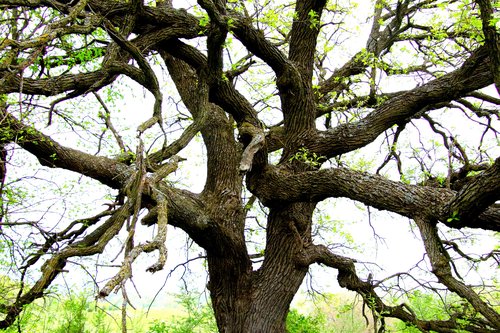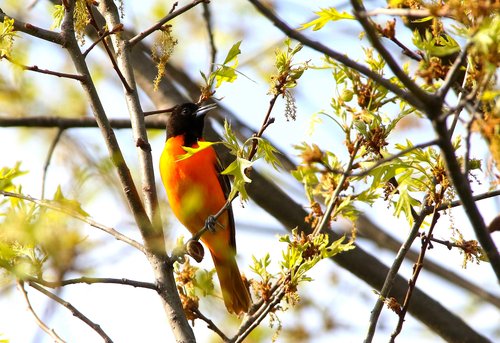Regardless of later pursuits, acquaint yourself with outdoors by hiking, looking, naming, determining stage of development, and abundance.
And while tramping check in with others by visiting, calling and texting.
Step into a deciduous forest, bordered by fields, roads, marshland, and streams. Walk slowly, carry a stick, have an open mind and turn around frequently to get a different perspective. That’s worked recently when searching for mushrooms.
A badger, no doubt, dug numerous holes into roadside banks. In an attempt to determine if the badger was making a home for her cubs, smoothing fresh soil wiped out old tracks.
The first marks to appear were those of a gobbler, but he didn’t appear to enter the cavity or even try; he stepped over the

On a ridgetop stands a leafing bur oak tree. Ecologists call this sign of strength an open grown oak, one that had little or no competition 125 years ago so its branches stretched straight out; some even drooped a bit. Pollen flowers were drying, while acorn flowers were too small to make their mark. They’ll drop as one-seeded fruit in October. Many other oaks take two years to reach maturity.
Question the monarch’s link in the ecosystem. What saved this beast from being consumed by other trees? Fire and then farming, no doubt. What depends on this tree for perching, shelter, food, and safety? Will progeny grow under its spreading limbs? Or will it take an elm, maple or basswood to tolerate the shade?
Frost reappears some late May mornings, but a new fawn, if dried, can get up to suckle. The peak fawning is about May 25 here is Wisconsin. Will a deer be here to eat sweet white oak acorns in autumn?
Ruby-throated hummingbirds have returned and a pair although the male is not home enough to be wed to the nest building, incubation, and feeding. The female presumably spent the past two summers here and built an extra nest, which never got used. Now she has a third, which is even more photo-friendly.
We may have forgotten that robins, orioles, and hummingbird live in forests, too. Several years ago I saw a male hummer (the only one with a ruby throat) deep in other oaks, swinging as though it were on a pendulum. I guessed, correctly, that this was the mating “dance” so I should have waited and watched as the two birds eventually spend time together on the ground.
Listening was in vain, I knew, for a male ruffed grouse’s drumming would not resound through the young oak leaves. A quick call to Bob on Spring Road asking if the bird who spent opening day of the 2022 gun deer season in Bob’s enclosed stand had survived and then drummed while Bob waited for his turkey to come strutting by.
No not such a happening, but Bob’s turkey, a 27-pound gobbler, had a huge bone spur on his breast bone, only to be covered over with mounds of white, delicious flesh.
But wait, Bob called back after returning from the stand during Period D and heard the sound so uncommon in Iowa County that he could hardly believe his ears. More turkey authorizations or not, Bob may return in the weeks ahead just to listen, maybe find the log and even see the bird.
Dipping lower on the slope and instead of hearing a grouse drum, a hen woodcock flushed and flew short. I looked in vain for the nest of 3-4 eggs, but saw none. Three chicks ran on weak legs and balanced with training wings. They didn’t go far but they may as well have been 100 yards away, never to be seen again.
The purple and white showy orchis are open but yellow lady’s-slippers are still in bud. The nearby large-flowered trillium appeared as giant snowflakes under a grove of sugar maples. They will fade pink when the yellow orchid blooms.

No amount of money could produce a pound of fresh morel mushrooms, regardless of how many white elms, abandoned apple trees, or prairie patches were examined. It was like looking for the last border piece in a jig-saw puzzle. Maybe next year things will be different, but if not that will make four consecutive years of worst morel season ever.
White and lemon yellow oyster mushrooms and an occasional, poisonous false morel filled the mold statement, one to eat, one to stay clear of.
Shagbark hickory buds are always amazing and confusing. They resemble flowers to the point of drawing attention again and again.
In a nearby park sat four benches, each cut from one of hundreds of dead ash tree boles. A five-foot log had been sawed longitudinally with a chain saw and one half rested on two short pieces, notched to hold the half log. Will they ever compete with a Leopold bench? They certainly are interesting.
Birds fill the woods with songs but are nearly impossible to see with the increasing foliage. There’s an app for this, which records the sound and then names the bird who sang.
Turkeys gobble, garlic mustard blooms, ginseng grows in quirky ways, catkins and pine cones cough pollen, and so many items go unnoticed, unnamed, unused and therefore unappreciated.
Hikes like this can change some of that.
Contact Jerry Davis, a freelance writer, at sivadjam@mhtc.net or 608.924.1112.





